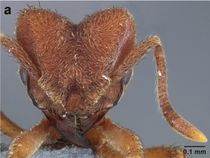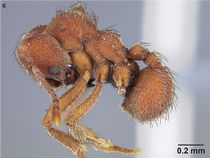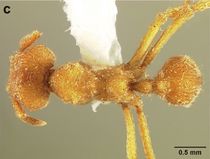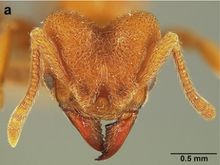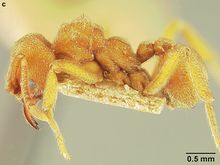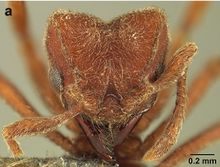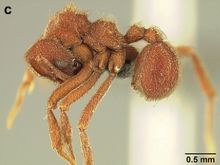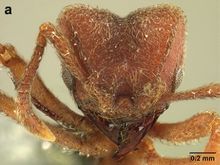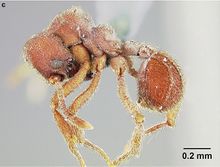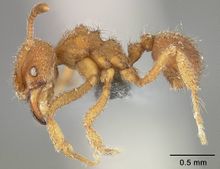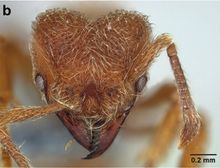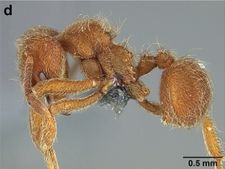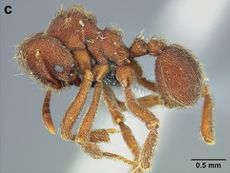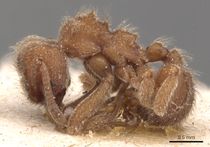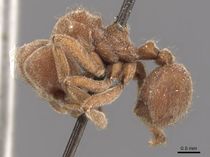Key to Sericomyrmex
This worker key is based on: Ješovnik, A. and Schultz, T.R. 2017. Revision of the fungus-farming ant genus Sericomyrmex Mayr (Hymenoptera, Formicidae, Myrmicinae). ZooKeys. 670:1–109. doi:10.3897/zookeys.670.11839
Ješovnik, A. and Schultzs' study also included extensive information regarding species identification in Sericomyrmex. The key is found after this text.
Worker General appearance. Worker color varies within species and even within single colonies and can be altered by collecting and preservation methods as well as by age, esaspecially in dried, pinned specimens. The body color of an individual Sericomyrmex worker is homogeneous except in some Sericomyrmex bondari individuals from Carajás, Brazil, and in a few workers of Sericomyrmex saussurei in which some, but not all, nestmate workers have lighter-colored areas on their heads. We refer to thicker, non-pubescent hairs simply as “hairs,” whereas, when referring to pubescence, we use the terms “pubescence” or “pubescent hairs.” The density of pubescence may vary both between and within species. Hair length, color, and degree of curvature (appressed to nearly erect) vary within species. Curvature in particular can be altered by collecting and preservation methods; for example, the hair of specimens collected by pitfall trapping may differ from that of workers from same nest collected directly into ethanol and subsequently point-mounted. Hair is, however, a useful character for recognizing the species S. bondari, which possesses uniquely thick, dark hairs.
Body size. Body size is a useful character for separating some species. Because it varies to some extent within species and within colonies, it should be used with caution and in combination with other characters. We use the combination of head width including the eyes (HWe), Weber’s length (WL), and hind femur length (HFL) as an approximation for body size to group Sericomyrmex species into three size categories. The mean values for the size categories are as follows: small (HW<0.92, WL<1.18, HFL<0.99); medium (HW=1.0–1.06, WL=1.28–1.39, HFL=1.1–1.24); and large (HW>1.15, WL>1.44, HFL>1.27).
Head. The head in Sericomyrmex is characteristically cordate, but the shape of the posterior corners and the size and shape of the posterior cephalic emargination vary between species. Here we distinguish between three main categories of posterior corner shape: 1) acute, in which (in dorsal, i.e., full-face view) the lateral and posterior cephalic margins meet at an angle of less than 90 degrees; 2) angular, in which these margins meet at an angle approaching 90 degrees and in which the lateral and posterior cephalic margins are more or less straight; and 3) rounded, in which the transition between the lateral and posterior margins is smoothly rounded and in which the lateral and posterior borders are usually convex. Even though intermediate states exist, these three character states are very useful in describing the variation across Sericomyrmex species and, in combination with other characters, are useful in distinguishing species.
The shape of the median cephalic emargination varies in a manner that can be broadly captured by two states: it can be gradually impressed or it can be abruptly impressed. Intermediate states also exist and in some species, particularly Sericomyrmex amabilis and S. saussurei, both states are often found within the same colony. However, the second (abruptly impressed) state predominates in the species Sericomyrmex mayri, whereas the gradual state almost always occurs in the species S. bondari, Sericomyrmex lutzi, Sericomyrmex maravalhas, Sericomyrmex opacus, Sericomyrmex parvulus, Sericomyrmex radioheadi, Sericomyrmex saramama, and Sericomyrmex scrobifer.
Mandibles. In most species (S. bondari, S. lutzi, S. maravalhas, S. opacus, S. parvulus, S. radioheadi, S. saramama, S. scrobifer) the dorsal surfaces of the mandibles are glossy and smooth, lacking any striae except for very short and faint ones restricted to the masticatory margin. In S. amabilis, S. saussurei, and S. mayri, however, the mandibles are dorsally striate. Exceptions occur in each species: smooth mandibles occur in some populations of S. amabilis in Costa Rica, Ecuador, and Colombia, in populations of S. saussurei mostly in southeast Brazil, and in populations of S. mayri in Trinidad and Tobago and in Suriname. In callow workers of all species, dorsal striation is not very distinct. An intermediate stage exists in all three species, with mandibles just partly or faintly striate. Because the presence of smooth mandibles may indicate either that a specimen belongs to one of the smooth-mandibled species or that it belongs to a rare population of an otherwise striate-mandibled species, additional characters obviously need to be examined for species diagnoses. The presence of striate mandibles, in contrast, always indicates that a specimen belongs to one of the three species with striate mandibles. There are no consistent differences between species in the number of teeth; in fact, the opposite mandible of a single specimen may have different numbers of teeth.
Eyes. Relative eye size, reflected in the ocular index (OI), varies moderately within most species (OI 14–16), but it is noticeably larger in two species, S. scrobifer and S. maravalhas (OI 18–19). For describing eye size, we use three categories based on OI value: “small” eyes for species with OI=14, “medium-sized” eyes for species with OI between 15–16 (the majority of species), and “large” eyes for species with OI 18–20. Eyes can be flat to strongly convex, the latter protruding from the lateral borders of the head. Most species have flat to mildly convex eyes, but the eyes of S. scrobifer and S. saussurei are consistently moderately (S. saussurei) or strongly (S. scrobifer) convex, so eye shape is useful for recognizing those species.
Another important character of the eyes is the presence or absence of a white, waxy layer. This layer may be absent; it may only partially cover the eyes (in S. parvulus), or it may completely cover them. When completely covering the eye it can be relatively thin, so that the individual ommatidia are still discernible (as in S. opacus), or it can be so thick that individual ommatidia are hard to distinguish (as in S. saussurei), even though in some individuals the centers of individual ommatidia can be seen showing through the white layer in rare adult individuals (as in some S. saussurei). Below we refer to this layer simply as a “white layer”; its origin, whether as a cuticular secretion or due to some other cause, remains the subject of future investigation.
Frontal lobes. Frontal lobe size and shape are useful characters for Sericomyrmex, and here we distinguish three main states: 1) trapeziform, in which the posterior margin of the frontal lobe is subequal in length to the medial margin and in which the angles between the lateral and the other two margins are subequal and often acute; 2) rectangular, similar to trapeziform, but in which the medial and posterior margins are parallel and in which the angles between the lateral and the other two margins approximate 90 degrees; and 3) triangular, in which the posterior margin is at least half the length of the medial margin, sometimes much less than half; in which the angle between the lateral and posterior margins is obtuse; and in which the angle between the lateral and medial margins is acute, and the lobe is directed anterad. Although variants and intermediate states occur, and some degree of variation frequently occurs between individuals in the same nest, frontal lobe shape remains a very informative character. The frontal lobes of S. scrobifer, for example, can vary from trapeziform to rectangular, but are never triangular; and the frontal lobes of S. bondari are always triangular and narrow, with long lateral margins. Among these three states, triangular is the one with the most variation.
Frontal carinae. The length, shape, and robustness of the frontal carinae vary between species, but also to some extent within species. Frontal carinae can be complete and robust or, at the opposite extreme, weak and incomplete, fading before reaching the posterior corners. Complete and robust frontal carinae are a good diagnostic criterion for some species (S. scrobifer, S. maravalhas), but the alternate state of reduced frontal carinae can be fairly variable within species, e.g., S. parvulus and S. mayri mostly have reduced frontal carinae, but in some indi-viduals or populations this is not the case, so this character must be examined across nest series and employed in conjunction with other characters.
Scape length. Scape index is a useful character only in combination with other characters and is diagnostic only for S. radioheadi, which has an unusually long scape.
Mesosoma and metasoma. The mesosomal tubercles and propodeal carinae and denticles are in general sharper and longer in some species and blunter and shorter in others. However, because within-species and even within-colony variation are common, this character must be used with caution. The same holds for the petiolar and postpetiolar denticles and carinae, which, again, can be more or less pronounced within workers of the same colony. The presence or absence of a pair of anteromedian dorsal carinae on the first gastral tergite is a more consistent character that in general holds well for S. scrobifer and S. maravalhas, in which it is strongly developed, and for S. parvulus and S. opacus, in which it is faint or completely absent. In S. amabilis and S. mayri it is variable (usually well developed but faint in some specimens).
Queen Characters that are useful for separating workers are also useful for separating queens, especially size, mandibular striation, and frontal lobe shape. A queen-specific character that is useful for separating queens of S. maravalhas from queens of similarly sized species is the presence of a full preocular carina. Queens of other species either have the preocular carinae ending posterior to the eye or have a few isolated, short, faint supraocular carinae that do not reach the posterior cephalic corners. The notauli, median mesoscutal line, and parapsidal lines, as well as the depth of the scutellar notch, can vary from prominent to very faint, but these variations seem to be as common within species as between species and are thus not useful for separating species.
Male Male genitalia show differences in the following characters: the apical triangular lobe on abdominal sternum IX (present/absent) and the volsellar cuspis either with a simple lobe (S. amabilis), with a single tooth (S. mayri, S. saussurei), or with several minute denticles (S. opacus). Further research is needed to determine character-state variability and distributions in Sericomyrmex male genitalia. Apart from genitalia and body size, we found no morphological characters of males useful for separating species, but this might be due to the small sample sizes and to the fact that we examined males for only five out of 11 species.
Larva Based on examination of the larvae of seven species, larval characters useful for separating Sericomyrmex species are the number of dorsal and lateral setae (ranging from absent in S. saramama and S. parvulus to ~30 in S. amabilis), supra-antennal setae (presence/absence), mandibular teeth (divided/undivided), number of genal setae (six in S. mayri, four in all others), the presence of an additional pair of anal setae (S. bondari only), and the number of setae on T1.
Key to the worker caste of Sericomyrmex When we refer to sizes or shapes we provide mean values, indicated with bold font, followed by ranges. Because of frequent overlap of minimum values of one species with maximum values of another, we advise users of this key to examine several individuals from the same nest/collection event whenever possible and to consult images and distribution maps when indicated. The mean values for the size categories are as follows: small (HW<0.92, Wl<1.18, HFL<0.99), medium (HW=1.0–1.06, WL=1.28–1.39, HFL=1.1–1.24), and large (HW>1.15, WL>1.44, HFL>1.27). All measurements are in millimeters.
You may also be interested in
1


- Mandible dorsally smooth except for fine transverse striae along the masticatory margin (Figure 6g, Figure 11a) . . . . . 2
- Mandible striate across the most or all of the dorsal surface (Figure 6h, 11b) . . . . . 12
2
return to couplet #1
- Entire body covered with thick, dark hair (Figure 11c). Large species (HWe=1.15, 0.96–1.4; WL=1.44, 1.25–1.76; HFL=1.27, 1.12–1.52), posterior cephalic emargination deep, frontal lobe narrow, triangular, directed anterad . . . . . Sericomyrmex bondari
- Body not covered with thick, dark hair (Figure 11d); small to large species; posterior cephalic margin from shallow to deep; frontal lobe variable . . . . . 3
3
return to couplet #2
- Mesosoma with very long and sharp lateral mesonotal tubercles (Figure 12c); scape long (SI=77, 75–82), reaching the posterior cephalic corner in full-face view (Figure 12a); posterior cephalic emargination deep (CEI=14, 12–17); frontal lobe narrow, triangular; medium-sized species . . . . . Sericomyrmex radioheadi
- Lateral mesonotal tubercles from low and obtuse to more developed, but never as long or as sharp as in radioheadi (Figure12d); scape relatively short (Figure 12b), cephalic emargination shallow to deep, size small to large, frontal lobe variable . . . . . 4
4
return to couplet #3
- Cephalic emargination deep (CEI=15, 16–17) (Figure 13a); mesosomal tubercles low and obtuse; body size large (HWe=1.22, 1.12–1.35; WL=1.52, 1.38–1.68; HFL=1.29, 1.2–1.4); probably endemic to Mt. Roraima and surrounding tepuis in Guyana, Brazil, and Venezuela . . . . . Sericomyrmex lutzi
- Either body size small to medium (HWe<1.06, WL<1.39, HFL<1.24) and cephalic emargination shallow to moderately deep (CEI=9–12), or body size large (HWe=1.35, 1.05–1.6; WL=1.71, 1.27–2.20; HFL=1.48, 1.15–1.70) and cephalic emargination shallow (Figure 13b) . . . . . 5
5
return to couplet #4
- Eye large (OI>18), frontal carina complete, usually robust (Figure 14a); body size small or medium; gaster with two lateral and two dorsal carinae strongly developed (Figure 14c) . . . . . 6
- Eye medium-sized (OI 14–16), frontal carina complete to incomplete, but not robust (Figure 14b), gaster with lateral carinae weakly to strongly developed, dorsal carinae absent or faint (Figure 14d) . . . . . 7
6
return to couplet #5
- Frontal lobe wide, trapeziform (FLI=76, 72–83), eye large, strongly convex, and strongly protruding from the sides of the head, medium-sized species (HWe=1.0, 0.84–1.12; WL=1.29, 1.12–1.4; HFL=1.11, 0.93–1.26) . . . . . Sericomyrmex scrobifer
- Frontal lobe triangular, narrower than in scrobifer (FLI=69, 64– 73), eye large, moderately protruding, small species (HWe=0.92, 0.8–0.98: WL=1.18, 1.03–1.28; HFL=0.99, 0.82–1.08) . . . . . Sericomyrmex maravalhas
7
return to couplet #5
- Small to medium-sized species (WL=1.04–1.28, 0.74–1.4), head relatively small, usually as long as broad (HWe= 0.81–1.01, 0.66–1.13; CI=100–102, 94–108), frontal lobe small and reduced, rectangular or triangular (Figure 15a–c) . . . . . 8
- Larger species (mean WL=1.33–1.71, 1.1–2.2 ), head relatively large, usually broader than long (HWe=1.02–1.34, 0.88–1.6; CI=104–107, 94–115), frontal lobe either triangular and diverging, or triangular and very narrow, directed anterad (Figure 15d–f) . . . . . 10
8
return to couplet #7
- Small species (WL=1.04, 0.74–1.23; HWe=0.82, 0.66–0.90; HFL=0.82, 0.65–0.99); frontal carina incomplete to complete, usually faint; frontal lobe small and triangular; eye small and flat, often covered with thin white layer (Figure 14b, d) . . . . . Sericomyrmex parvulus
- Small to medium-sized species (mean WL =1.15–1.28, mean HWe=0.9– 1.01); frontal carina incomplete or complete; frontal lobe rectangular to triangular; eye larger and without white layer or smaller in size and with white layer (as in parvulus), but then frontal lobe rectangular . . . . . 9
9
return to couplet #8
- Small-sized species (WL=1.16, 0.99–1.30; HWe=0.91, 0.8–1.0; HFL=0.92, 0.8–1.02); frontal lobe rectangular (Figure 15b); head corners smoothly rounded; eye often with transparent white layer . . . . . Sericomyrmex opacus
- Medium-sized species (WL=1.28, 1.12–1.40; HWe=1.01, 0.90–1.13; HFL=1.10, 0.95–1.20); frontal lobe triangular (Figure 15c); eye without white layer . . . . . Sericomyrmex saramama
10
return to couplet #7
- Eye distinctly convex, mildly protruding, covered with thick white layer that makes it difficult to discern individual ommatidia (Figure 15e, 16a); medium-sized species . . . . . smooth-mandibled variant of Sericomyrmex saussurei
- Eye flat to mildly convex, without white layer, ommatidia visible; medium-sized to large (WL=1.37–1.71; HWe=1.06–1.35) . . . . . 11
11
return to couplet #10
- Large species (WL=1.71, 1.27–2.20; HWe=1.35, 1.05–1.60; HFL=1.48, 1.15–1.70); head broad (CI=108, 101–115); posterior cephalic corner acute to rectangular; frontal lobe narrow (FLI=63, 59–68), directed anterad; frontal carina often incomplete (Figure 16c); distribution: Colombia to Bolivia and Brazil . . . . . smooth-mandibled variant of Sericomyrmex mayri
- Medium-sized species (WL=1.37, 1.13–1.60; HWe=1.06, 0.88–1.21; HFL=1.15, 0.93–1.38); head narrower than mayri (CI=104, 97–111); posterior cephalic corner acute to rounded; frontal lobe relatively wide (FLI=68, 60–72), directed laterally; frontal carina complete (Figure 16b); distribution: Mexico to Venezuela and Ecuador . . . . . smooth-mandibled-variant of Sericomyrmex amabilis
12
return to couplet #1
- Eye distinctly convex, mildly protruding, covered with thick white layer that makes it difficult to discern individual ommatidia (Figure 15e, 16a); medium-sized species . . . . . Sericomyrmex saussurei
- Eye flat to mildly convex, without white layer, ommatidia visible; medium-sized to large species (WL=1.37–1.71; HWe=1.06–1.35) . . . . . 13
13
return to couplet #12
- Large species (WL=1.71, 1.27–2.20; HWe=1.35, 1.05–1.60; HFL=1.48, 1.15–1.70); head broad (CI=108, 101–115); posterior cephalic corner acute to rectangular; frontal lobe narrow (FLI=63, 59–68), directed anterad; frontal carina often incomplete (Figure 16c); distribution: Colombia to Bolivia and Brazil . . . . . Sericomyrmex mayri
- Medium-sized species (WL=1.37, 1.13–1.60; HWe=1.06, 0.88–1.21; HFL=1.15, 0.93–1.38); head narrower than mayri (CI=104, 97–111); posterior cephalic corner acute to rounded; frontal lobe relatively wide (FLI=68, 60–72), directed laterally; frontal carina complete (Figure 16b); distribution: Mexico to Venezuela and Ecuador . . . . . Sericomyrmex amabilis





